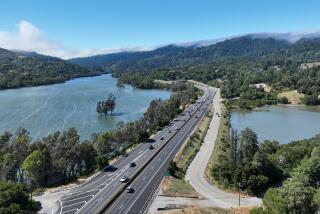New York taking a safer, more roundabout route
- Share via
ALBANY, N.Y. — New York drivers are finding themselves going in circles, and it’s not because they’re lost.
Following a national trend, state transportation planners are turning right-angle intersections into roundabouts, derided by many but proven in a national study to be safer than some intersections with stop signs or traffic signals.
Traffic circles have long been part of New York roadways, but modern roundabouts are distinctly different. At about 100 to 200 feet in diameter, today’s roundabouts are about half the size of older traffic circles.
Transportation planners say the newer design -- which originated in Europe and found its way to the United States around 1990 -- results in improved traffic flow and fewer accidents.
“The No. 1 reason we’re doing these is safety,” said Howard McCulloch, a traffic engineer with the New York State Department of Transportation who specializes in roundabouts.
At intersections with stop signs or traffic lights, the most common -- and serious -- accidents are right-angle, left-turn, or head-on collisions that can be severe because vehicles may be moving fast. Roundabouts virtually eliminate those types of crashes because vehicles all travel in the same direction.
Roundabouts also tend to keep cars moving steadily in all directions. That cuts down on fuel-wasting stop-and-go traffic and reduces air pollution, giving planners another reason to use them, said Wade Scarbrough, a roundabout specialist with Kittelson & Associates, a transportation engineering and consulting firm in Portland, Ore.
“There are times when there’s such a huge amount of traffic that they get backed up, but for the most part, it’s a steady flow,” Scarbrough said.
The Federal Highway Administration -- which oversees federal money spent on highway construction and maintenance -- estimates 150 to 250 roundabouts are being built each year and supports a goal to raise that to roughly 1,000 a year, said Doug Hecox, an agency spokesman.
Since New York started its roundabout-building program in the late 1990s, it has installed them at 42 intersections, and the projects often meet with stiff community resistance, McCulloch said.
“I’ve seen people who are pretty levelheaded get really emotional,” he said.
The exact number of roundabouts in New York, or nationwide, is unclear because no single state or federal agency keeps track of them all.
Richard Retting, a transportation engineer with the Insurance Institute for Highway Safety, estimates about 1,000 have been built so far, and the pace is accelerating because 23 states from Alaska to Florida have active roundabout-construction programs.
Roundabout proposals frequently elicit strong opposition from drivers, but those opinions quickly change when they become familiar with them, Retting said.
McCulloch attributes much of the opposition to roundabouts to people confusing them with the older traffic circles and the consternation that they can sometimes cause drivers.
Corrine Weeks, a teacher from Voorheesville, N.Y., who said she became quite familiar with roundabouts during an eight-month sabbatical in England in the late 1980s, doesn’t like driving through them.
“I just find them very uncomfortable,” she said. “You have to constantly be looking over your shoulder, and it just doesn’t feel safe to me having to basically guess what the other person is going to do.”
William Hotaling, a former public works superintendent from the village of Voorheesville, was one of the most vocal opponents and led a campaign against the state’s plan to put a roundabout in his community.
Nearly five years later, Hotaling grudgingly acknowledges the roundabout works the way transportation planners said it would. “It’s not very attractive to look at, with the signs all around it,” he said. “But does it work? Yes. I can’t argue with that. It does slow people down.”
A study by the insurance institute of 24 intersections before and after roundabouts found the new device reduced the number of injury-causing crashes by 76% and crashes that caused fatal or incapacitating injuries by 90%.
Some communities worry that drivers will avoid roundabouts, pushing more traffic to adjacent streets.
The insurance institute, which some federal agencies rely on for roundabout research, hasn’t analyzed the effect on traffic volumes.
More to Read
Sign up for Essential California
The most important California stories and recommendations in your inbox every morning.
You may occasionally receive promotional content from the Los Angeles Times.













